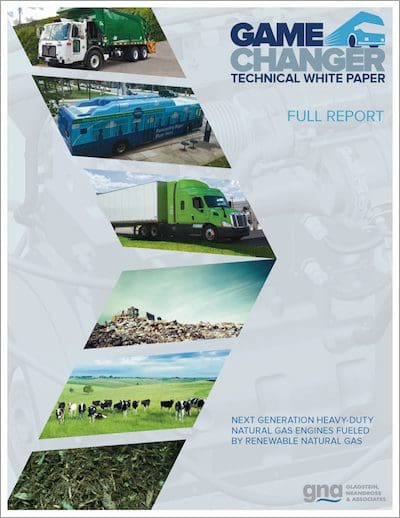
Game Changer: Next Generation Heavy-Duty Natural Gas Engines Fueled by Renewable Natural Gas
Published May 2016
Client: Agility Fuel Systems; American Gas Association; California Natural Gas Vehicle Partnership; Clean Energy Fuels; Pacific Gas and Electric Company; South Coast Air Quality Management District; Southern California Gas Company
Abstract
This White Paper explores the need—and leading approaches—to immediately start deploying zero‑emission and near‑zero‑emission heavy‑duty vehicle (HDV) technologies on a wide‑scale basis in the United States. Expeditious action is needed to reduce smog‑forming emissions from HDVs to restore healthful air quality—as is legally required under the federal Clean Air Act—for approximately 166 million Americans who reside in areas with exceedingly poor air quality. At the same time, to combat global climate change, the United States must aggressively reduce greenhouse gas (GHG) emissions from HDVs, which are the fastest growing segment of U.S. transportation for energy use and emissions.
In many regions of the U.S., these goals cannot be achieved without a systematic transformation of today’s diesel‑fueled HDVs—particularly high‑fuel‑use heavy‑heavy‑duty vehicles (HHDVs)—to zero‑ or near‑zero‑emission technologies operated on low‑carbon fuels. Four unique fuel‑technology combinations currently hold the most promise to successfully achieve this transformation. These are two types of advanced low‑emission internal combustion engines (fueled increasingly by renewable natural gas or renewable diesel); and two types of electric‑drive systems (powered by batteries or hydrogen fuel cells). Over the long term (several decades), it is likely that all four of these HDV architectures will contribute to meeting air quality and climate change goals.
However, air quality regulators have recognized that meeting air quality goals will require the immediate deployment of zero‑ and/or near‑zero‑emission HDVs, especially in the most impactful HHDV applications like on‑road goods movement trucking. This White Paper documents that only one fuel‑technology platform meets all the commercial feasibility and logistics tests to immediately begin this transformation: near‑zero‑emission heavy‑duty NGVs fueled by increasing volumes of ultra‑low‑GHG renewable natural gas (RNG).
In 2015, Cummins Westport certified the world’s first heavy‑duty engine at near‑zero‑emission levels (90 percent below the existing federal standard). To complement the NOx reductions provided by this landmark engine, conventional (fossil) natural gas provides significant GHG‑reduction benefits. However, RNG completes the game‑changing proposition by providing the lowest carbon intensity of any heavy‑duty transportation fuel available in the market today. RNG can immediately provide deep GHG emission reductions when used in either in‑use or new heavy‑duty NGVs. Expanded RNG production in America can offer an array of environmental and economic benefits; these include enhanced job creation, improved air quality, and a number of environmental waste stream management improvements that will accrue at local levels.
Near-zero-emission natural gas engines using RNG provide a commercially proven, broad‑based, and affordable strategy to immediately achieve major reductions in emissions of criteria pollutants, air toxins, and GHGs from America’s on‑road HDV sector. The 9‑liter near‑zero‑emission engine being deployed today offers broad, immediate applicability in several HDV sectors that power our freight and public transportation systems (transit buses, refuse haulers, and short‑haul delivery trucks). By 2018, Cummins Westport will certify and commercialize a near‑zero‑emission version of its existing 12‑liter natural gas engine designed for HHDV applications. This 12‑liter engine provides diesel‑like performance for tractor‑trailer trucks hauling 80,000 pounds over long distances and up steep grades, as routinely needed for goods movement trucking throughout our nation’s interstate highway system. Notably, when near‑zero‑emission HHDVs with this engine begin to roll out in 2018, some large operator fleets will already be using significant volumes of ultra‑low‑GHG RNG to supplement (or entirely replace) fossil gas use.
With nearly the full range of HDVs covered, the combination of new near‑zero‑emission natural gas engine technology and RNG provides the single best opportunity for America to achieve immediate and substantial NOx and GHG emission reductions in the on‑road heavy‑duty transportation sectors. Equally important, major reductions of cancer‑causing toxic air contaminants can immediately be realized in disadvantaged communities adjacent to freeways and areas of high diesel engine activity, where relief is most urgently needed.
While the opportunity and potential benefits to widely deploying near-zero-emission heavy-duty NGVs are quite large, significant challenges must be systematically and expediently addressed. This White Paper describes recommended actions for government and industry stakeholders that will help meet these challenges and immediately begin broad deployments of near‑zero‑emission heavy‑duty NGVs, using progressively greater volumes of ultra‑low‑GHG RNG. First and foremost, national, state, and local incentive funding programs should be established or strengthened that 1) subsidize the higher costs to produce and deploy these new‑generation heavy‑duty NGVs, and 2) help produce and transport RNG, where the economics and logistics are most conducive. Recommendations are provided about how to allocate available incentive funds toward deployments that can immediately and cost-effectively achieve large reductions for key pollutants.
